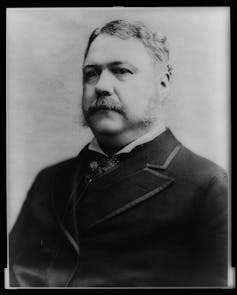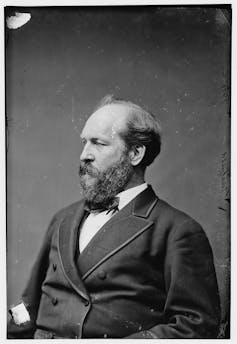The Trump administration wants to dismantle the agency overseeing 2 million federal workers – and weaken safeguards against partisanship
- Written by Matthew May, Senior Research Associate, Boise State University
The U.S. government has put expertise and competence[1] ahead of political considerations when it hires people for more than 135 years.
As a result of changes made during President Chester Arthur’s administration, the vast majority of government jobs[2] can only be awarded on the basis of merit[3]. Prospective employees historically had to complete a competitive exam[4] and today must complete detailed applications[5], undergo interviews and get their background checked. Employees also cannot be fired or demoted for political reasons.
These rules apply to all but about 4,000 politically appointed[6] employees among the 2 million people[7] who work for the federal government, not counting postal service workers. Those only require presidential support and, for around 1,200 of these jobs, Senate confirmation[8].
 Safeguards began making the federal workforce more neutral when Chester Arthur was in the White House.
Charles Milton Bell[9]
Safeguards began making the federal workforce more neutral when Chester Arthur was in the White House.
Charles Milton Bell[9]
The Trump administration is taking several steps that could remove safeguards against partisanship and nepotism in the federal workforce. Among other things, it is pushing to dissolve the Office of Personnel Management[10], which oversees the administration of the civil service system. Democrats[11] are objecting to this move.
As a public administration researcher[12], I look at how political partisanship influences the relationship between government employees and elected officials.
To understand why scholars like me and other experts are concerned that dismantling OPM could harm the civil service system by making it more partisan, it is helpful to understand why the U.S. moved toward a merit-based system in the first place.
To the victor goes the spoils
For about a century following independence from Britain, the U.S. federal workforce operated under a patronage system[13]. Also called the spoils system[14], it gave elected politicians complete control over the federal workforce, allowing them to dole out government jobs to their most ardent supporters and remove partisan foes.
The political party in power profited directly from the spoils system because a portion of every appointee’s paycheck would be earmarked as a mandatory campaign contribution. By the late 1870s, these mandatory contributions accounted for three-quarters[15] of all campaign contributions.
This emphasis on political loyalty meant that numerous federal employees were either unqualified, unethical or both. Federal government employees were implicated in many bribery scandals, involving everything from regulating railroads[16] to overseeing the whiskey[17] business to awarding contracts for trading posts[18] at military forts.
Even so, members of both major political parties[19] tried to reform the spoils system but were largely unsuccessful until a tragedy brought about change.
An assassination spurs reform
Charles J. Guiteau, a man who by many accounts was suffering from mental illness, shot President James Garfield[20] on July 2, 1881. Garfield soon died from infections related to the gunshot wound.
Guiteau was furious over being denied a federal job despite his perception that he had personally helped Garfield win. The assassination led to a public outcry and widespread demands for personnel reforms.
 James Garfield’s assassin said he was angry about not getting a federal job he believed he was due.
Brady-Handy photograph collection, Library of Congress, Prints and Photographs Division[21]
James Garfield’s assassin said he was angry about not getting a federal job he believed he was due.
Brady-Handy photograph collection, Library of Congress, Prints and Photographs Division[21]
A bipartisan legislative majority passed the Pendleton Act[22] in 1883. The law established open competitive exams for most government positions. The goal was to ensure that civil servants were capable of doing their jobs, while letting presidents retain the ability to appoint the most senior positions. That same system remains largely in place today, administered by three agencies since[23] 1978.
Not down with OPM
One of those three agencies is the Office of Personnel Management[24], which the Trump administration wants to dismantle and then move its civil service functions elsewhere. Most of the agency’s responsibilities would land within the General Services Administration[25], which currently oversees the government’s real estate and procurement.
House Democrats and federal labor leaders[26] want to block the move[27]. They say it is unwarranted and could inject partisanship[28] into the federal hiring process – meaning that members of the party in the White House would get the bulk of all new civil service jobs.
OPM is an independent federal agency[29] overseen by Congress. Heads of independent agencies are appointed by the president and confirmed by the Senate, but unlike Cabinet members, they cannot be fired without cause[30]. This makes them more autonomous than other executive branch agencies and partially insulates them from presidential directives.
The Office of Management and Budget[31], which would take over the administration of federal workforce policy[32] if OPM no longer exists, is an executive branch agency under the president’s direct control. Under this arrangement, Trump could potentially exert more influence over those policies, which he has already shown a willingness[33] to do.
In May of 2018, President Trump issued three executive orders[34] designed to make it easier to fire federal employees and limit the power of federal labor unions. A federal judge blocked the orders[35] a few months later, but some agencies are still trying to independently implement[36] the changes.
More grievances
The three-seat U.S. Merit Systems Protection Board[37] is another agency that grew out of the Civil Service Commission. It is charged with adjudicating employee grievances within the civil service system and has lacked a quorum since a few weeks before Trump took office[38] in January 2017. It has a backlog of more than 2,100 cases waiting[39] to be heard.
The term of its last remaining member[40], Mark Robbins[41], expired in March 2019. All board positions have been vacant since then, pending Senate approval[42] of Trump’s three nominees.
 When he was the last remaining member of the Merit Systems Protection Board, Mark Robbins was unable to move forward with any of the panel’s business.
AP Photo/Juliet Linderman[43]
When he was the last remaining member of the Merit Systems Protection Board, Mark Robbins was unable to move forward with any of the panel’s business.
AP Photo/Juliet Linderman[43]
The Federal Labor Relations Authority[44], the third agency that grew out of the Civil Service Commission, administers labor-management relations for non-postal service federal employees. In June 2019, a union representing more than 8,000 Environmental Protection Agency employees filed a grievance[45] with the authority over the Trump administration’s plans to limit telework to one day a week and make it easier to fire EPA staff. The workplace changes are similar to those included in executive orders Trump had signed but which got tied up in court[46].
In addition to dismantling OPM, the Trump administration plans to relocate[47] a total of about 550 jobs[48] at two Washington, D.C.-based U.S. Department of Agriculture research agencies to Kansas City[49].
Even before the USDA announced the new workplace site in June 2019, giving these researchers one month to decide whether to move to Kansas City, many had resigned. Some staff members have argued that the reorganization is a form of retaliation[50] against the researchers for their findings that are sometimes at odds with Trump administration policies on issues, such as the degree to which Supplemental Nutrition Assistance Program[51] benefits – also known as food stamps – help millions of Americans.
The official rationale for the move is that it will cut costs[52].
[ Deep knowledge, daily. Sign up for The Conversation’s newsletter[53]. ]
References
- ^ expertise and competence (www.ourdocuments.gov)
- ^ vast majority of government jobs (www.theguardian.com)
- ^ awarded on the basis of merit (courses.lumenlearning.com)
- ^ competitive exam (www.federaljobs.net)
- ^ detailed applications (www.dol.gov)
- ^ politically appointed (www.thoughtco.com)
- ^ 2 million people (www.governing.com)
- ^ Senate confirmation (www.everycrsreport.com)
- ^ Charles Milton Bell (cdn.loc.gov)
- ^ dissolve the Office of Personnel Management (www.washingtonpost.com)
- ^ Democrats (www.rollcall.com)
- ^ public administration researcher (scholarworks.boisestate.edu)
- ^ patronage system (doi.org)
- ^ the spoils system (www.britannica.com)
- ^ accounted for three-quarters (www.doi.org)
- ^ railroads (www.history.com)
- ^ whiskey (www.history.com)
- ^ trading posts (www.encyclopedia.com)
- ^ members of both major political parties (doi.org)
- ^ President James Garfield (www.smithsonianmag.com)
- ^ Brady-Handy photograph collection, Library of Congress, Prints and Photographs Division (www.loc.gov)
- ^ Pendleton Act (www.britannica.com)
- ^ three agencies since (ballotpedia.org)
- ^ Office of Personnel Management (www.opm.gov)
- ^ General Services Administration (www.gsa.gov)
- ^ federal labor leaders (federalnewsnetwork.com)
- ^ to block the move (www.cnn.com)
- ^ inject partisanship (www.rollcall.com)
- ^ independent federal agency (www.usa.gov)
- ^ cannot be fired without cause (www.thoughtco.com)
- ^ Office of Management and Budget (www.whitehouse.gov)
- ^ federal workforce policy (www.washingtonpost.com)
- ^ already shown a willingness (www.politico.com)
- ^ three executive orders (www.businessinsider.com)
- ^ blocked the orders (www.reuters.com)
- ^ independently implement (www.govexec.com)
- ^ U.S. Merit Systems Protection Board (www.mspb.gov)
- ^ lacked a quorum since a few weeks before Trump took office (www.washingtonpost.com)
- ^ more than 2,100 cases waiting (www.fedweek.com)
- ^ last remaining member (www.apnews.com)
- ^ Mark Robbins (www.fedsmith.com)
- ^ pending Senate approval (www.govexec.com)
- ^ AP Photo/Juliet Linderman (www.apimages.com)
- ^ Federal Labor Relations Authority (www.flra.gov)
- ^ filed a grievance (federalnewsnetwork.com)
- ^ got tied up in court (www.govexec.com)
- ^ plans to relocate (www.politico.com)
- ^ about 550 jobs (www.washingtonpost.com)
- ^ Department of Agriculture research agencies to Kansas City (www.usda.gov)
- ^ argued that the reorganization is a form of retaliation (www.politico.com)
- ^ Supplemental Nutrition Assistance Program (www.npr.org)
- ^ cut costs (www.usda.gov)
- ^ Sign up for The Conversation’s newsletter (theconversation.com)
Authors: Matthew May, Senior Research Associate, Boise State University

